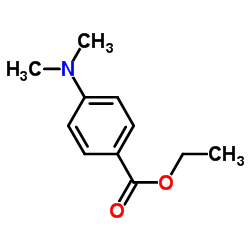Ethyl 4-dimethylaminobenzoate

Ethyl 4-dimethylaminobenzoate structure
|
Common Name | Ethyl 4-dimethylaminobenzoate | ||
|---|---|---|---|---|
| CAS Number | 10287-53-3 | Molecular Weight | 193.242 | |
| Density | 1.1±0.1 g/cm3 | Boiling Point | 296.5±23.0 °C at 760 mmHg | |
| Molecular Formula | C11H15NO2 | Melting Point | 63-66 °C(lit.) | |
| MSDS | Chinese USA | Flash Point | 115.0±13.5 °C | |
|
Effect of methacrylated-based antibacterial monomer on orthodontic adhesive system properties.
Am. J. Orthod. Dentofacial Orthop. 147(4 Suppl) , S82-7, (2015) Antibacterial adhesives were developed to reduce the incidence of white spot lesions in orthodontic patients. Compounds that contain triazine are known as effective antibacterial agents. The aims of this study were to develop an experimental orthodontic adhes... |
|
|
Calcium and phosphate release from resin-based materials containing different calcium orthophosphate nanoparticles.
J. Biomed. Mater. Res. B. Appl. Biomater. 103 , 1670-8, (2015) The study compared ion release from resin-based materials containing calcium orthophosphates. Amorphous calcium phosphate (ACP), dicalcium phosphate anhydrous (DCPA), dicalcium phosphate dihydrate (DCPD), and tricalcium phosphate (β-TCP) nanoparticles were ch... |
|
|
Effect of Different In Vitro Aging Methods on Color Stability of a Dental Resin-Based Composite Using CIELAB and CIEDE2000 Color-Difference Formulas.
J. Esthet. Restor. Dent. 27 , 322-30, (2015) To evaluate the effect of different in vitro aging methods on color change (CC) of an experimental dental resin-based composite using CIELAB (ΔEab ) and CIEDE2000 (ΔE00 ) color-difference formulas.The CC was evaluated with a spectrophotometer (CM700d, Konica ... |
|
|
Characterization of (18)F-dipicolylamine (DPA) derivatives in cells infected with influenza virus.
Nucl. Med. Biol. 42(3) , 283-91, (2015) Bis(Zn-dipicolylamine (Zn-DPA)) coordination complexes represent a new class of synthetic small molecules that can target anionic phosphatidylserine (PS) in the apoptotic cells with high affinity and specificity. In this study, we labeled Zn-DPA and Cy7-Zn-DP... |
|
|
Incorporation of bactericidal poly-acrylic acid modified copper iodide particles into adhesive resins.
J. Dent. 43 , 546-55, (2015) This study aimed to investigate incorporation of polyacrylic acid (PAA) coated copper iodide (CuI) nanoparticles into dental adhesives, and to evaluate for the first time, their antibacterial properties, bond strength and cytotoxicity.PAA-CuI nanoparticles we... |
|
|
Evaluation of a commercial primer for bonding of zirconia to two different resin composite cements.
J. Adhes. Dent. 16(2) , 169-76, (2014) To evaluate the effects of a commercial zirconia primer (Choice or RelyX Unicem) on shear bond strength (SBS) of two different resin composite cements - Choice (a conventional bis-GMA-based resin cement) and RelyX Unicem (self-adhesive resin cement) - to zirc... |
|
|
Determination of leachable components from four commercial dental composites by gas and liquid chromatography/mass spectrometry.
J. Dent. 26(2) , 137-45, (1998) The purpose of our study was to determine the quality and quantity of leachable residual (co)monomers and additives eluted from various commercial dental composite resins after polymerization.Polymerized specimens from four universal hybrid-type composite res... |
|
|
Slow-acting amine polymerization accelerators. Para-dimethylaminobenzoic acid and its ethyl ester.
J. Dent. Res. 60(7) , 1325-31, (1981)
|
|
|
Method development in quantitative NMR towards metrologically traceable organic certified reference materials used as (31)P qNMR standards.
Anal. Bioanal. Chem 407 , 3115-3123, (2015) Quantitative nuclear magnetic resonance (qNMR) spectroscopy is employed by an increasing number of analytical and industrial laboratories for the assignment of content and quantitative determination of impurities. Within the last few years, it was demonstrate... |
|
|
Using high-performance ¹H NMR (HP-qNMR®) for the certification of organic reference materials under accreditation guidelines--describing the overall process with focus on homogeneity and stability assessment.
J. Pharm. Biomed. Anal. 93 , 102-110, (2014) Quantitative NMR spectroscopy (qNMR) is gaining interest across both analytical and industrial research applications and has become an essential tool for the content assignment and quantitative determination of impurities. The key benefits of using qNMR as me... |